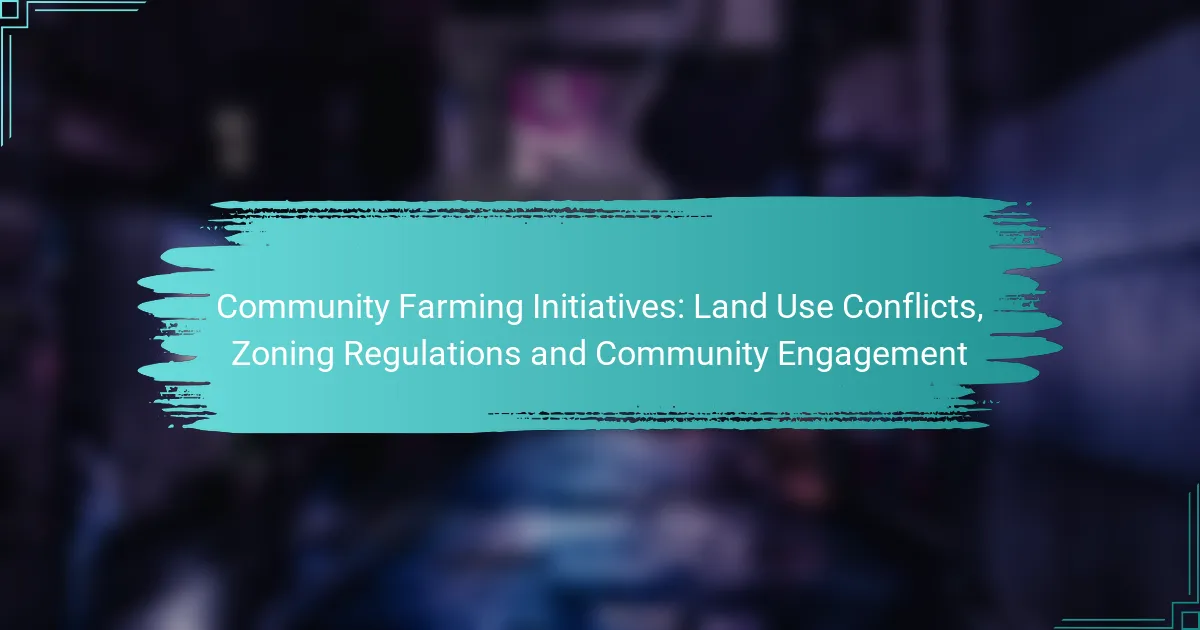Community farming initiatives represent a vital collaboration among local residents to cultivate land for agricultural purposes, aiming to enhance food security and strengthen community ties. However, these efforts often face significant challenges due to land use conflicts and zoning regulations, which can create disputes over land rights and resource allocation. Understanding the complexities of these regulations is essential for successfully establishing and maintaining community farms in urban environments.

What are community farming initiatives?
Community farming initiatives are collaborative efforts that involve local residents working together to cultivate land for agricultural purposes. These initiatives aim to enhance food security, promote sustainable practices, and strengthen community ties.
Definition of community farming
Community farming refers to the collective management of agricultural land by a group of individuals or organizations. This can include urban gardens, cooperative farms, or shared agricultural projects where participants contribute labor, resources, and knowledge to grow food for themselves and the community.
These initiatives often emphasize sustainable practices, local food production, and education about agriculture, nutrition, and environmental stewardship. They can vary in size and scope, from small community gardens to larger cooperative farms.
Examples of community farming initiatives
Examples of community farming initiatives include urban community gardens, which transform vacant lots into productive green spaces, and cooperative farms where members share the costs and benefits of farming. Another example is community-supported agriculture (CSA), where consumers buy shares of a farm’s harvest in advance, providing farmers with upfront capital.
In the United States, initiatives like the GreenThumb program in New York City support over 600 community gardens, while in Europe, projects like the Incredible Edible movement in the UK encourage communities to grow food in public spaces. These initiatives not only provide fresh produce but also foster social connections and community resilience.

How do land use conflicts affect community farming?
Land use conflicts can significantly hinder community farming by creating disputes over land rights, zoning regulations, and resource allocation. These conflicts often arise when agricultural needs clash with urban development or environmental protections, leading to challenges in establishing and maintaining community farms.
Types of land use conflicts
Land use conflicts typically fall into several categories, including residential versus agricultural land use, commercial development versus green spaces, and environmental conservation versus farming activities. For instance, a community farm may face opposition from developers seeking to build housing projects on the same land. Additionally, conflicts can arise when local governments impose zoning regulations that restrict farming activities in certain areas.
Another common type of conflict involves competing interests among community members, such as differing opinions on how land should be utilized. This can lead to tensions within the community, making it essential for stakeholders to engage in open dialogue to find common ground.
Impact on community farming projects
Land use conflicts can severely impact community farming projects by limiting access to land, increasing operational costs, and creating legal hurdles. When conflicts arise, farmers may face delays in obtaining necessary permits or even risk losing their land altogether. This uncertainty can deter investment and participation in community farming initiatives.
Moreover, these conflicts can undermine community engagement and support for farming projects. If residents feel that their interests are not being considered, they may withdraw their support, making it difficult for community farms to thrive. To mitigate these impacts, it is crucial for community farms to actively involve local stakeholders in decision-making processes and advocate for policies that support sustainable land use practices.

What zoning regulations apply to community farming in urban areas?
Zoning regulations for community farming in urban areas often dictate land use, structure placement, and operational guidelines. These regulations can vary significantly by municipality, impacting how community farms are established and maintained.
Common zoning regulations
Common zoning regulations affecting community farming include land use designations, setback requirements, and restrictions on the types of structures allowed. For instance, some areas may designate specific zones for agricultural use, while others may limit farming activities to residential or mixed-use zones. Setback requirements often dictate how far structures must be from property lines, which can influence the layout of community gardens.
Additionally, regulations may address noise, odor, and waste management, ensuring that farming activities do not disrupt neighboring properties. Understanding these regulations is crucial for community farming initiatives to operate legally and effectively.
Case studies of zoning impacts
In cities like Portland, Oregon, community farms have thrived under supportive zoning regulations that encourage urban agriculture. The city has implemented policies that allow for farming in residential zones, which has led to increased food access and community engagement. This case illustrates how favorable zoning can enhance local food systems.
Conversely, in some areas of New York City, restrictive zoning has limited the establishment of community farms. Regulations that classify land as commercial or industrial can hinder agricultural use, leading to conflicts between developers and community advocates. These examples highlight the significant impact zoning can have on the viability and success of community farming initiatives.

How can communities engage in farming initiatives?
Communities can engage in farming initiatives by fostering collaboration among residents, local organizations, and government entities. This engagement often involves creating platforms for discussion, sharing resources, and developing shared goals that reflect the community’s agricultural aspirations.
Strategies for community engagement
Effective strategies for community engagement in farming initiatives include organizing workshops, community meetings, and farm tours. These events can help raise awareness and gather input on local agricultural needs and preferences.
Utilizing social media and local newsletters can also enhance outreach, allowing for broader participation. Establishing community gardens or cooperative farms can serve as practical examples of engagement, providing hands-on experience and fostering a sense of ownership among participants.
Role of local organizations
Local organizations play a crucial role in supporting community farming initiatives by providing resources, expertise, and networking opportunities. They can facilitate partnerships between farmers and community members, helping to bridge gaps in knowledge and access to land.
Additionally, these organizations often assist in navigating zoning regulations and land use conflicts, ensuring that community farming efforts comply with local laws. By offering training programs and workshops, they empower residents to take active roles in sustainable farming practices and community engagement.

What are the benefits of community farming initiatives?
Community farming initiatives offer numerous advantages, including enhanced local food production, improved environmental health, and strengthened community ties. These initiatives foster collaboration among residents while promoting sustainable practices that benefit both people and the planet.
Environmental benefits
Community farming initiatives contribute significantly to environmental sustainability by promoting biodiversity and reducing carbon footprints. By utilizing local resources and organic practices, these farms help improve soil health and water quality.
Additionally, they can mitigate urban heat effects and enhance green spaces in densely populated areas. For example, community gardens can lower temperatures in neighborhoods, making them more livable during hot months.
Social benefits
Socially, community farming initiatives foster a sense of belonging and encourage collaboration among diverse groups. They provide opportunities for education, skill development, and cultural exchange, bringing together individuals from various backgrounds.
Moreover, these initiatives can improve food security by increasing access to fresh produce, particularly in food deserts. Engaging local residents in farming activities can also lead to stronger community networks and support systems, enhancing overall well-being.

What challenges do community farming initiatives face?
Community farming initiatives encounter various challenges, including funding limitations, zoning regulations, and differing levels of community support. These obstacles can hinder the establishment and sustainability of such projects, impacting their ability to thrive and serve local needs.
Funding and resource challenges
Securing funding is a primary challenge for community farming initiatives, as they often rely on grants, donations, and local government support. Many projects struggle to obtain sufficient financial resources, which can limit their capacity to purchase land, seeds, and necessary equipment.
Additionally, ongoing operational costs can strain budgets. Initiatives may consider diversifying funding sources through crowdfunding, partnerships with local businesses, or membership models to enhance financial stability.
Community resistance and support
Community farming initiatives may face resistance from local residents who are concerned about land use changes or potential impacts on property values. Engaging with the community early in the planning process is essential to address these concerns and build support.
On the other hand, strong community support can significantly enhance the success of these initiatives. Organizing workshops, open houses, and volunteer days can foster a sense of ownership and collaboration, helping to bridge gaps between farmers and residents.

How can communities navigate zoning regulations for farming?
Communities can navigate zoning regulations for farming by understanding local laws and engaging with stakeholders. This involves researching zoning classifications, identifying permissible activities, and actively participating in local governance.
Steps to address zoning issues
To effectively address zoning issues, communities should begin by reviewing local zoning ordinances. This includes identifying specific regulations that impact agricultural activities, such as land use designations and restrictions on farm structures.
Next, communities can gather input from local farmers and residents to understand their needs and concerns. Forming a coalition or working group can help consolidate voices and streamline efforts to advocate for necessary changes.
Finally, communities should consider proposing amendments to zoning laws that support sustainable farming practices. This may involve drafting proposals that align with community goals and presenting them to local planning commissions.
Collaboration with local authorities
Collaboration with local authorities is crucial for successful navigation of zoning regulations. Establishing open lines of communication with city planners and zoning boards can facilitate a better understanding of the regulatory landscape.
Communities should seek to engage local officials in discussions about the benefits of community farming initiatives. Highlighting economic, environmental, and social advantages can help garner support for more flexible zoning policies.
Additionally, participating in public hearings and community meetings allows residents to voice their opinions and influence decision-making. Building relationships with local authorities can lead to more favorable outcomes for community farming projects.

What role does policy play in community farming?
Policy plays a crucial role in shaping community farming by establishing the legal framework for land use, zoning regulations, and community engagement. Effective policies can promote sustainable practices, protect agricultural land, and facilitate local food systems.
Land use conflicts
Land use conflicts arise when community farming initiatives compete with other land uses, such as residential or commercial development. These conflicts can lead to tensions between farmers and developers, often requiring mediation or policy intervention to resolve disputes.
To mitigate land use conflicts, communities should engage in comprehensive planning that considers agricultural needs alongside urban development. Establishing clear zoning regulations that protect farmland can help prevent encroachment and preserve agricultural viability.
Zoning regulations
Zoning regulations dictate how land can be used and significantly impact community farming. These regulations can either support or hinder farming activities, depending on how they are structured. For instance, some areas may have restrictive zoning that limits agricultural operations, while others may promote urban agriculture.
Communities should advocate for zoning policies that recognize the importance of local food production. This may include creating agricultural zones, allowing for mixed-use developments that incorporate farming, or providing incentives for community gardens and urban farms.
Community engagement
Community engagement is vital for the success of community farming initiatives. Involving local residents in decision-making processes fosters a sense of ownership and encourages participation in farming activities. Effective engagement can lead to stronger support for policies that benefit local agriculture.
To enhance community engagement, organizers should hold public meetings, workshops, and outreach programs that educate residents about the benefits of community farming. Building partnerships with local organizations can also amplify efforts and ensure diverse voices are heard in policy discussions.
